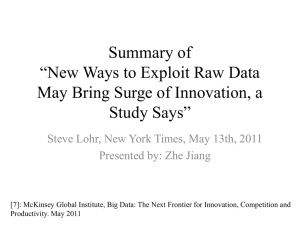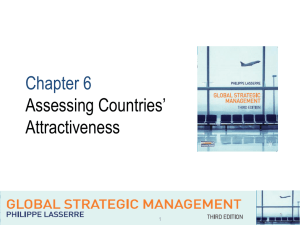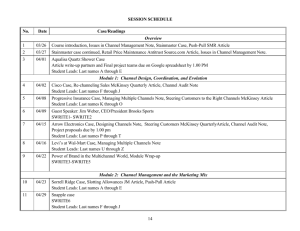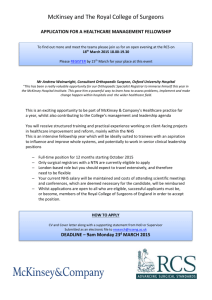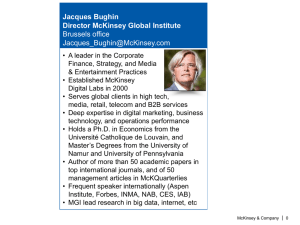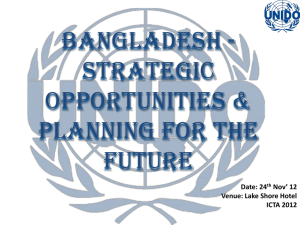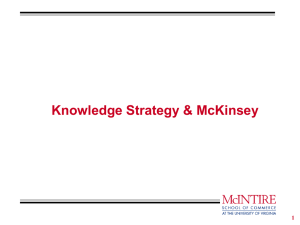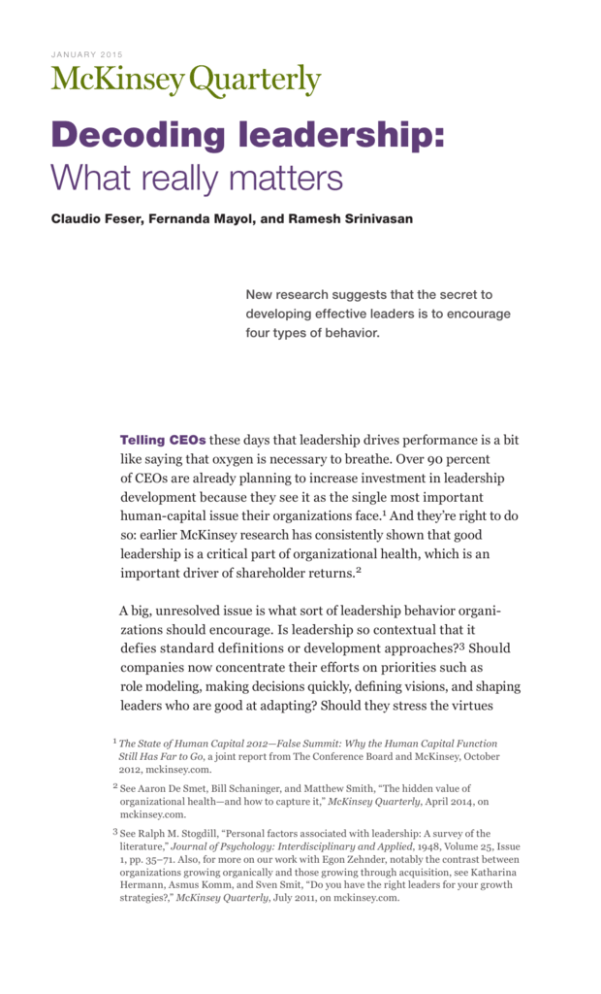
J A N UA RY 2 015
Decoding leadership:
What really matters
Claudio Feser, Fernanda Mayol, and Ramesh Srinivasan
New research suggests that the secret to
developing effective leaders is to encourage
four types of behavior.
Telling CEOs these days that leadership drives performance is a bit
like saying that oxygen is necessary to breathe. Over 90 percent
of CEOs are already planning to increase investment in leadership
development because they see it as the single most important
human-capital issue their organizations face.1 And they’re right to do
so: earlier McKinsey research has consistently shown that good
leadership is a critical part of organizational health, which is an
important driver of shareholder returns.2
A big, unresolved issue is what sort of leadership behavior organizations should encourage. Is leadership so contextual that it
defies standard definitions or development approaches?3 Should
companies now concentrate their efforts on priorities such as
role modeling, making decisions quickly, defining visions, and shaping
leaders who are good at adapting? Should they stress the virtues
1 The
State of Human Capital 2012—False Summit: Why the Human Capital Function
Still Has Far to Go, a joint report from The Conference Board and McKinsey, October
2012, mckinsey.com.
2 See
Aaron De Smet, Bill Schaninger, and Matthew Smith, “The hidden value of
organizational health—and how to capture it,” McKinsey Quarterly, April 2014, on
mckinsey.com.
3 See
Ralph M. Stogdill, “Personal factors associated with leadership: A survey of the
literature,” Journal of Psychology: Interdisciplinary and Applied, 1948, Volume 25, Issue
1, pp. 35–71. Also, for more on our work with Egon Zehnder, notably the contrast between
organizations growing organically and those growing through acquisition, see Katharina
Hermann, Asmus Komm, and Sven Smit, “Do you have the right leaders for your growth
strategies?,” McKinsey Quarterly, July 2011, on mckinsey.com.
2
of enthusiastic communication? In the absence of any academic or
practitioner consensus on the answers, leadership-development
programs address an extraordinary range of issues, which may help
explain why only 43 percent of CEOs are confident that their
training investments will bear fruit.
Our most recent research, however, suggests that a small subset of
leadership skills closely correlates with leadership success, particularly
among frontline leaders. Using our own practical experience
and searching the relevant academic literature, we came up with a
comprehensive list of 20 distinct leadership traits. Next, we surveyed
189,000 people in 81 diverse organizations4 around the world to
assess how frequently certain kinds of leadership behavior are applied
within their organizations. Finally, we divided the sample into organizations whose leadership performance was strong (the top quartile
of leadership effectiveness as measured by McKinsey’s Organizational
Health Index) and those that were weak (bottom quartile).
What we found was that leaders in organizations with high-quality
leadership teams typically displayed 4 of the 20 possible types
of behavior; these 4, indeed, explained 89 percent of the variance
between strong and weak organizations in terms of leadership
effectiveness (exhibit).
•
olving problems effectively. The process that precedes decision
S
making is problem solving, when information is gathered, analyzed,
and considered. This is deceptively difficult to get right, yet it is
a key input into decision making for major issues (such as M&A) as
well as daily ones (such as how to handle a team dispute).
•
Operating
with a strong results orientation. Leadership is about
not only developing and communicating a vision and setting
objectives but also following through to achieve results. Leaders
with a strong results orientation tend to emphasize the importance
of efficiency and productivity and to prioritize the highest-value work.
4 The 81 organizations are diverse in geography (for instance, Asia, Europe, Latin America,
and North America), industry (agriculture, consulting, energy, government, insurance,
mining, and real estate), and size (from about 7,500 employees to 300,000).
3
eeking different perspectives. This trait is conspicuous in manS
agers who monitor trends affecting organizations, grasp changes
in the environment, encourage employees to contribute ideas that
could improve performance, accurately differentiate between
important and unimportant issues, and give the appropriate weight
to stakeholder concerns. Leaders who do well on this dimension
typically base their decisions on sound analysis and avoid the many
Q4 2014
biases to which decisions are prone.
Leadership Decoded
Exhibit 1 of 1
•
Exhibit
Four kinds of behavior account for 89 percent of leadership
effectiveness.
Top kinds of leadership behavior1
1 Be supportive
11 Keep group organized and on task
2 Champion desired change
12 Make quality decisions
3 Clarify objectives, rewards, and consequences
13 Motivate and bring out best in others
4 Communicate prolifically and enthusiastically
14 Offer a critical perspective
5 Develop others
15 Operate with strong results orientation
6 Develop and share a collective mission
16 Recover positively from failures
7 Differentiate among followers
17 Remain composed and confident in uncertainty
8 Facilitate group collaboration
18 Role model organizational values
9 Foster mutual respect
19 Seek different perspectives
10 Give praise
1 Based
20
Solve problems effectively
on a survey of 81 organizations that are diverse in geography (eg, Asia, Europe, Latin America, and North
America), industry (eg, agriculture, consulting, energy, government, insurance, mining, and real estate), and size
(from ~7,500 to 300,000 employees).
Source: McKinsey’s Organizational Health Index
4
•
upporting others. Leaders who are supportive understand and
S
sense how other people feel. By showing authenticity and a sincere
interest in those around them, they build trust and inspire and
help colleagues to overcome challenges. They intervene in group
work to promote organizational efficiency, allaying unwarranted
fears about external threats and preventing the energy of employees
from dissipating into internal conflict.
We’re not saying that the centuries-old debate about what distinguishes great leaders is over or that context is unimportant.
Experience shows that different business situations often require
different styles of leadership. We do believe, however, that our
research points to a kind of core leadership behavior that will be
relevant to most companies today, notably on the front line. For
organizations investing in the development of their future leaders,
prioritizing these four areas is a good place to start.
The authors wish to thank Michael Bazigos, Nate Boaz, Aaron De Smet,
Lili Duan, Chris Gagnon, Bill Schaninger, and Ekaterina Titova for their contributions
to this article.
Claudio Feser is a director in McKinsey’s Zürich office, Fernanda Mayol is
an associate principal in the Rio de Janeiro office, and Ramesh Srinivasan is a
director in the New York office.
Copyright © 2014 McKinsey & Company.
All rights reserved.

